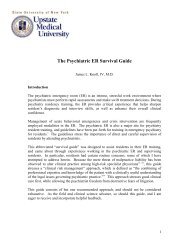Synchronicity Cambray
Synchronicity Cambray
Synchronicity Cambray
Create successful ePaper yourself
Turn your PDF publications into a flip-book with our unique Google optimized e-Paper software.
While the pathway from communal identity to Athenian democracy<br />
had many elements, a crucial step came at the end of the sixth<br />
century BCE. For the following account I draw upon Manville and<br />
Ober. 10 In the face of the loss of the democratic process 11 with the<br />
invasion of the Spartans in 508 BCE, Cleisthenes used his visionary<br />
leadership in the surprising Athenian victory over the Spartans to<br />
institute a series of reforms. For the purposes of this text, the relevant<br />
aspect was Cleisthenes’ revision of the deme, the system of membership<br />
in a local neighborhood (by this period every male Athenian over<br />
the age of eighteen was eligible to become a citizen by being formally<br />
voted into the local deme).<br />
Now Cleisthenes redrew the demes, redistributing by lottery the<br />
entire population into ten new “tribes.” These new deme were deliberately<br />
made up of individuals drawn from each of the major areas of<br />
the activity of the city (geographic and economic), especially farmers<br />
(agrarian villages), seafarers (coastal regions), and merchants (urban<br />
center). These ten composite units were then organized in such a<br />
fashion as to form the military and civic services, and their representatives<br />
formed the overall general assembly. Because of the large size<br />
of the assembly (the general body was a council of five hundred) and<br />
the short terms of office for most posts, most citizens had multiple<br />
opportunities over a lifetime to be directly involved in the political life<br />
of the city, to the point that “politics became the dominant element in<br />
the life of the community.” 12<br />
The rearrangement and engagement of individuals into a network<br />
of networks to create complex wholes that have the capacity for selforganization<br />
strongly indicates this society was built on an intuition<br />
of what has been mentioned throughout this text as scale-free networks.<br />
Recall that one of their key features is emergent properties:<br />
individual interactions that combine, especially within a competitive<br />
environment, to form a linked network that has new features unforeseeable<br />
from the perspective of the interactions alone. The properties<br />
of the whole transcend any and all of the individuals and their<br />
interactions. These types of networks are highly robust to a variety<br />
of attacks, although knocking out major centers, “hubs,” can cripple<br />
them. 13 Strikingly adaptive, they exhibit many features that suggest<br />
Cultural Synchronicities ( 9 )









